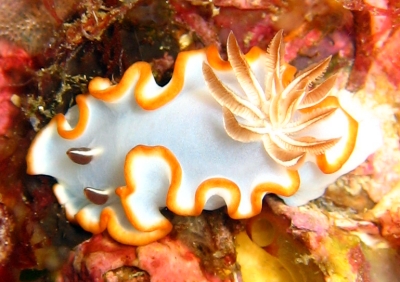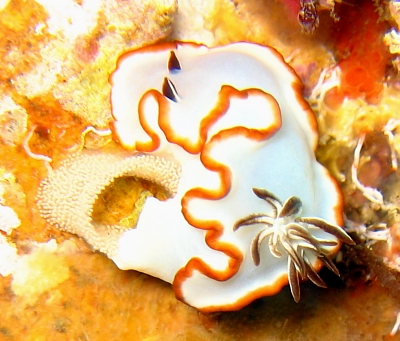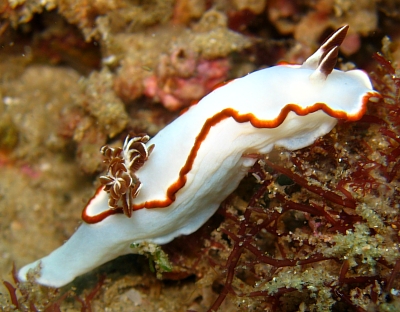Glossodoris averni or G. angasi?
April 14, 2006
From: Bruce Wilkie


Hi Bill,
I have been doing a lot of um-ing and ah-ing over these animals. I originally had them listed under Glossodoris averni, until I had a closer look at them I noticed several differences.
1. The mantle colour is more brown than yellow/orange as in G. averni.
2. The colour of the rhinophores and gills are black. In G. averni they seem to be similar colour to the mantle border.
3. In G. averni the mantle border has a lot more folds and ruffles.(except in photo 1 )
Locality: Upper photo: Manta Bommie Point Lookout North Stradbroke Island, 12 metres, Queensland Australia, Pacific Ocean, 01 November 2005, rocky reef with sponges, hard & soft corals . Length: 40mm. Middle photo: Same locality - 31 December 2005, 10 m. Lower photo: Same locality - 25 February 2006, 12 m. Photographer: Bruce Wilkie.
I ruled them out as being Glossodoris atromarginata because the ones I find here are distinctly black and white and have a very ruffled mantle border. I hope I have identified these animals correctly as Glossodoris angasi?; I have also enclosed photo of egg laying.
Many Thanks,
Bruce Wilkie.
brucedwilkie@yahoo.com.au
Wilkie,B, 2006 (Apr 14) Glossodoris averni or G. angasi?. [Message in] Sea Slug Forum. Australian Museum, Sydney. Available from http://www.seaslugforum.net/find/16306
Dear Bruce,
They are all G. averni. The rhinophores and gills certainly don't appear to be black to me, the rhinophore clubs are brownish but the gills are certainly nearer the colour of the mantle edge. It is interesting that the animal in the lowest photo has quite brown pigmentation. Every now and then I see photos of an animal with a brown border without even the reddish tinge found in your animal. I have suspected they are a brown form of G. averni, and I think your lower two photos show a link between that brown form and the more usual colour form with a red or orange-red border. As to the degree of folding of the mantle edge, this varies in quite a few species of Glossodoris, wth larger animals often showing a much more folded mantle than younger animals.
It's also good to get the photo of the egg ribbon. From the relatively large eggs I would suspect this species has either a fairly short non-feeding larval stage [lecithotrophic] or perhaps young slugs hatch directly from the egg ribbon without a swimming veliger stage at all.
Best wishes,
Bill Rudman
Related messages
-
Re: Glossodoris averni or G. angasi?
From: Bruce Wilkie, April 25, 2006 -
Re: Glossodoris averni or G. angasi?
From: Bruce Wilkie, April 20, 2006 -
Re: Glossodoris averni or G. angasi?
From: Bruce Wilkie, April 19, 2006 -
Re: Glossodoris averni or G. angasi?
From: Nerida Wilson, April 19, 2006 -
Glossodoris averni? from Sydney
From: Nicholas Missenden, June 17, 2005 -
Glossodoris averni from Philippines
From: Jeff Rosenfeld, November 30, 2002 -
Glossodoris averni from Sydney
From: Akos Lumnitzer, December 1, 1998
